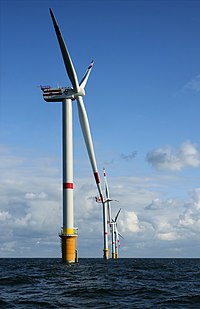
A wind turbine is a rotary device that extracts energy from the wind. If the mechanical energy is used directly by machinery, such as for pumping water, cutting lumber or grinding stones, the machine is called a windmill. If the mechanical energy is instead converted to electricity, the machine is called a wind generator, wind turbine, wind turbine generator (WTG), wind power unit (WPU), wind energy converter (WEC), or aerogenerator.
Wind machines were used in Persia as early as 200 B.C.[2] The windwheel of Heron of Alexandria marks one of the first known instances of wind powering a machine in history.[3][4] However, the first practical windmills were built inSistan, a region between Afghanistan and Iran, from the 7th century. These were vertical axle windmills, which had long vertical driveshafts with rectangle-shaped blades.[5] Made of six to twelve sails covered in reed matting or clothmaterial, these windmills were used to grind corn and draw up water, and were used in the gristmilling and sugarcane industries.[6]
By the 14th century, Dutch windmills were in use to drain areas of the Rhine River delta. In Denmark by 1900, there were about 2500 windmills for mechanical loads such as pumps and mills, producing an estimated combined peak power of about 30 MW. The first known electricity generating windmill operated, was a battery charging machine installed in 1887 by James Blyth in Scotland.[7] The first windmill for electricity production in the United States was built in Cleveland, Ohio by Charles F Brush in 1888, and in 1908 there were 72 wind-driven electric generators from 5 kW to 25 kW. The largest machines were on 24 m (79 ft) towers with four-bladed 23 m (75 ft) diameter rotors. Around the time of World War I, American windmill makers were producing 100,000 farm windmills each year, mostly for water-pumping.[8] By the 1930s, windmills for electricity were common on farms, mostly in the United States where distribution systems had not yet been installed. In this period, high-tensile steel was cheap, and windmills were placed atop prefabricated open steel lattice towers.
A forerunner of modern horizontal-axis wind generators was in service at Yalta, USSR in 1931. This was a 100 kW generator on a 30 m (100 ft) tower, connected to the local 6.3 kV distribution system. It was reported to have an annual capacity factor of 32 per cent, not much different from current wind machines.[9] In the fall of 1941, the first megawatt-class wind turbine was synchronized to a utility grid in Vermont. The Smith-Putnam wind turbine only ran for 1100 hours. Due to war time material shortages the unit was not repaired.
The first utility grid-connected wind turbine operated in the UK was built by John Brown & Company in 1954 in the Orkney Islands. It had an 18 meter diameter, three-bladed rotor and a rated output of 100 kW.










